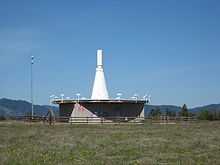Low-frequency radio range

The low-frequency radio range (LFR), also known as the four-course radio range, LF/MF four-course radio range, A-N radio range, Adcock radio range, or commonly "the range", was the main navigation system used by aircraft for instrument flying in the 1930s and 1940s, until the advent of the VHF omnidirectional range (VOR), beginning in the late 1940s. It was used for en route navigation as well as instrument approaches and holds.[1][2][3]
Based on a network of radio towers which transmitted directional radio signals, the LFR defined specific airways in the sky. Pilots navigated the LFR by listening to a stream of automated "A" and "N" Morse codes. For example, they would turn the aircraft to the right when hearing an "N" stream ("dah-dit, dah-dit, ..."), to the left when hearing an "A" stream ("di-dah, di-dah, ..."), and fly straight ahead while hearing a steady tone.[4]
As the VOR system was phased in around the world, the LFR was gradually phased out, mostly disappearing by the 1970s. There are no remaining operational LFR facilities today. At its maximum deployment, there were nearly 400 LFR stations in the U.S. alone.[2]
History
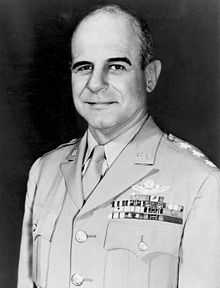
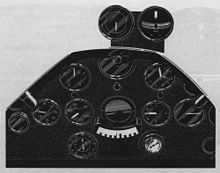
After World War I, aviation began to expand its role into the civilian arena, starting with airmail flights. It soon became apparent that for reliable mail delivery, as well as the passenger flights which were soon to follow, a solution was required for navigation at night and in poor visibility. In the U.S., a network of lighted beacons, similar to maritime lighthouses, was constructed for the airmail pilots. But the beacons were useful mostly at night and in good weather, while in poor visibility conditions they could not be seen. Scientists and engineers realized that a radio based navigation solution would allow pilots to "see" under all flight conditions, and decided a network of directional radio beams was needed.[5]
On September 24, 1929, then-Lieutenant (later General) James H. "Jimmy" Doolittle, U.S. Army, demonstrated the first "blind" flight, performed exclusively by reference to instruments and without outside visibility, and proved that instrument flying was feasible.[6][7] Doolittle used newly developed gyroscopic instruments—attitude indicator and gyrocompass—to help him maintain his aircraft's attitude and heading, and a specially designed directional radio system to navigate to and from the airport.[8][note 1] Doolittle's experimental equipment was purpose-built for his demonstration flights; for instrument flying to become practical, the technology had to be reliable, mass-produced and widely deployed, both on the ground and in the aircraft fleet.[5]
There were two technological approaches for both the ground and air radio navigation components, which were being evaluated during the late 1920s and early 1930s.
On the ground, to obtain directional radio beams with a well-defined navigable course, crossed loop antennas were used initially. The first loop-based LFR system was commissioned by the U.S. Commerce Department on June 30, 1928.[2][5] But the loop antenna design suffered from poor performance, especially at night, and by 1932 the Adcock antenna array, which had superior accuracy, became the preferred solution and replaced the loop antennas. The U.S. Commerce Department's Aeronautics Branch referred to the Adcock solution as the "T-L Antenna" (for "Transmission Line") and did not initially mention Adcock's name.[5][9]
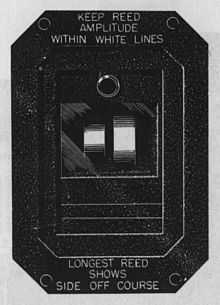
In the air, there were also two competing designs, originating from groups of different backgrounds and needs. The Army Signal Corps, representing military aviators, preferred a solution based on a stream of audio navigation signals, constantly fed into the pilots' ears via a headset. Civilian pilots on the other hand, who were mostly airmail pilots flying cross-country to deliver the mail, felt the audio signals would be annoying and difficult to use over long flights, and preferred a visual solution, with an indicator in the instrument panel.[5]
A visual indicator was developed based on vibrating reeds, which provided a simple panel-mounted "turn left-right" indicator. It was reliable, easy to use and more immune to erroneous signals than the competing audio based system. Pilots who had flown with both aural and visual systems strongly preferred the visual type, according to a published report.[5][10] The reed-based solution was passed over by the U.S. government, however, and the audio signals became standard for decades to come.[5][9]
By the 1930s the LFR network of ground-based radio transmitters, coupled with on board AM radio receivers, became a vital part of instrument flying. LFR provided navigational guidance to aircraft for en route operations and approaches, under virtually all weather conditions, helping to make consistent and reliable flight schedules a reality.[4]
LFR remained as the main radio navigation system in the U.S. and other countries until it was gradually replaced by the much-improved VHF-based VOR technology, starting in the late 1940s. The VOR, still used today, includes a visual left-right indicator.[2][9][11][12]
Technology
Ground
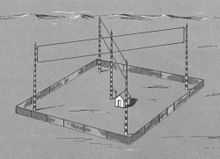
The LFR ground component consisted of a network of radio transmission stations which were strategically located around the country, often near larger airports, approximately 200 miles apart. Early LFR stations used crossed loop antennas, but later designs were all based on the Adcock vertical antenna array for improved performance, especially at night.[3][5]
Each Adcock range station had four 134-foot-tall (41 m) antenna towers erected on the corners of a 425 × 425 ft square, with an optional extra tower in the center for voice transmission and homing.[3][5][9] The stations emitted directional electromagnetic radiation at 190 to 535 kHz and 1,500 watts, into four quadrants.[1][13][note 2] The radiation of one opposing quadrant pair was modulated (at an audio frequency of 1,020 Hz) with a Morse code for the letter A (· —), and the other pair with the letter N (— ·).[note 3] The intersections between the quadrants defined four course lines emanating from the transmitting station, along four compass directions, where the A and N signals were of equal intensity, with their combined Morse codes merging into a steady 1,020 Hz audio tone. These course lines (also called "legs"), where only a tone could be heard, defined the airways.[11]

In addition to the repeating A or N modulation signal, each transmitting station would also transmit its two-letter Morse code identifier once every thirty seconds for positive identification.[14] The station identification would be sent twice: first on the N pair of transmitters, then on the A, to ensure coverage in all quadrants.[3][note 4] Also, in some installations local weather conditions were periodically broadcast in voice over the range frequency, preempting the navigational signals, but eventually this was done on the central fifth tower.[15][note 5]
The LFR was originally accompanied by airway beacons, which were used as a visual backup, especially for night flights.[4] Additional "marker beacons" (low power VHF radio transmitters) were sometimes included as supplementary orientation points.[16]
Air
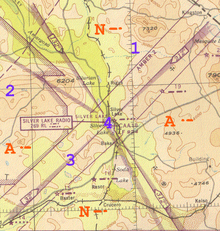
The airborne radio receivers—initially simple Amplitude Modulation (AM) sets—were tuned to the frequency of the LFR ground transmitters, and the Morse code audio was detected and amplified into speakers, typically in headsets worn by the pilots.[4] The pilots would constantly listen to the audio signal, and attempt to fly the aircraft along the course lines ("flying the beam"), where a uniform tone would be heard. If the signal of a single letter (A or N) became audibly distinct, the aircraft would be turned as needed so that the modulation of the two letters would overlap again, and the Morse code audio would become a steady tone.[2] The "on course" region, where the A and N audibly merged, was approximately 3° wide, which translated into a course width of ±2.6 miles when 100 miles away from the station.[4]
Pilots had to verify that they were tuned to the correct range station frequency by comparing its Morse code identifier against the one published on their navigation charts. They would also verify they were flying towards or away from the station, by determining if the signal level (i.e. the audible tone volume) was getting stronger or weaker, respectively.[4]
Approaches and holds
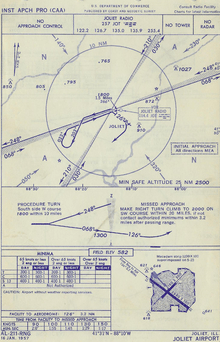
Final approach segments of LFR instrument approaches were normally flown near the range station, which ensured increased accuracy. When the aircraft was over the station, the audio signal disappeared, since there was no modulation signal directly above the transmitting towers. This quiet zone, called the "Cone of Silence", signified to the pilots that the aircraft was directly overhead the station, serving as a positive ground reference point for the approach procedure.[2][4]
In a typical LFR instrument approach procedure, final approach would begin over the range station, with a turn to a specific course. The pilot would descend to a specified minimum descent altitude (MDA), and if the airport was not in sight within a specified time (based on ground speed), a missed approach procedure would be initiated. In the depicted Joliet, IL LFR approach procedure, minimum descent altitude could be as low as 300 feet AGL, and required minimum visibility one mile, depending on aircraft type.[16][17]
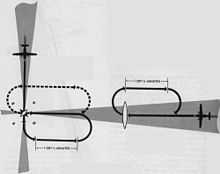
The LFR also allowed air traffic control to instruct pilots to enter a holding pattern "on the beam", i.e. on one of the LFR legs, with the holding fix (key turning point) over the LFR station, in the Cone of Silence, or over one of the fan markers. The holds were used either during the en route portion of a flight or as part of the approach procedure near the terminal airport. LFR holds were more accurate than NDB holds, since NDB holding courses are predicated on the accuracy of the on board magnetic compass, whereas the LFR hold was as accurate as the LFR leg, with an approximate course width of 3°.[3]
Non-directional beacons
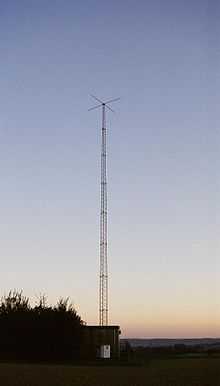
The LFR required a complex ground installation (four to five antenna towers per station) and careful monitoring of its signals, producing directional radio waves which defined flyable airways, with only a simple AM receiver needed on board the aircraft. From its beginning in the early 1930s, the LFR was augmented with Low Frequency Non-directional beacons (NDBs), which were simple, single-antenna transmitters, whose radio emission pattern was uniform in all directions in the horizontal plane. Coupled with a more complex on-board receiver, called radio direction finder (RDF), used to detect the phase of incoming waves, NDB allowed pilots to determine their azimuth to the transmitting station, and to navigate to or from the station in conjunction with their magnetic compass. Early RDF receivers were costly, bulky and difficult to operate, but the simpler and less expensive ground installation allowed the easy addition of NDB based waypoints and approaches, to supplement the LFR system.[4]
Modern RDF receivers, called "automatic direction finders" are small, low cost and easy to operate, and the NDB remains today as a supplement and backup to VOR and GPS navigation, although it is gradually being phased out.[18][19]
Limitations
Although the LFR system was used for decades as the main aeronautical navigation method during low visibility and night flying, it had some well known limitations and drawbacks. The course lines, which were a result of a balance between the radiation patterns from different transmitters, would fluctuate depending on weather conditions, vegetation or snow cover near the station, and even the airborne receiver's antenna angle. Under some conditions, the signals from the A quadrant would "skip" into the N quadrant (or vice versa), causing a false "virtual course" away from any real course line. Also, thunderstorms and other atmospheric disturbances would create electromagnetic interference to disrupt the range signals and produce crackling "static" in the pilots' headsets.[15]
Replacement by VOR
The LFR navigation system required, at a minimum, only a simple AM radio receiver on board the aircraft to accurately navigate the airways under instrument meteorological conditions, and even execute an instrument approach to low minimums.[note 6] On the downside, however, it had only four course directions per station, was sensitive to atmospheric and other types of interference and aberrations, and required pilots to listen for hours to an annoying monotonous beep, or a faint stream of Morse codes, often embedded in background "static". Its eventual replacement, the VHF band VOR navigation system, had many advantages. The VOR was virtually immune to interference, had 360 available course directions, had a visual "on course" display (with no listening needed), and was far easier to use.[12] Consequently, when the VOR system became available in the early 1950s its acceptance was rapid, and within a decade the LFR was mostly phased out. VOR itself is gradually being phased out today in favor of the far superior Global Positioning System (GPS).[9][19]
Sounds
The following are simulated sounds for the Silver Lake LFR. The range station—located about 10 miles north of Baker, California—would preempt the navigational signals every 30 seconds to transmit its Morse code identifier ("RL"). The station identification would be heard once or twice, possibly with different relative amplitudes, depending on the aircraft location.[3] Pilots would listen to and navigate by these sounds for hours while flying.[2][4] Actual sounds contained "static", interference and other distortions, not reproduced by the simulation.[4] Adjusting the volume would affect the effective course width.[3] For example, in the simulated sound for "twilight" A below, where the aircraft is nearly on the beam but slightly inside the A quadrant, a low volume almost obscures the weak A sound, whereas a loud one makes it more distinct.
 |
"Distinct" A
Inside A quadrant |
 |
"Distinct" N
Inside N quadrant |
 |
"On the beam"
A+N intersection |
 |
"Twilight" A
Slightly off beam in A |
(See Wikipedia:Media help if you encounter problems playing these sound files.)
Notes
- ↑ Doolittle also used a standard turn and bank instrument which was relatively common by the time of his flight.[8]
- ↑ According to international standards, the frequency band below 300kHz is "Low Frequency", and above that "Medium Frequency". Since LFR frequencies "straddled" the dividing line between the two bands, they were technically called "Low Frequency/Medium Frequency (LF/MF) Radio Range" stations.
- ↑ In the U.S. the quadrant which included the true north radial was designated as N (if a course leg was exactly on true north, then the northwest quadrant became N); in Canada, N was the quadrant which included the 045° true radial.[3]
- ↑ Since the station identification was transmitted in sequence, first on the N and then the A antenna pairs, it would be heard by the pilot once or twice, possibly with different relative amplitudes, depending on aircraft location. For example, it would be heard twice when on the beam, and only once when inside a quadrant.[3]
- ↑ Pilots had to request to stop the weather report if they were using the LFR for an approach.[3]
- ↑ Basic flight instruments would still be needed.
See also
References
- ↑ 1.0 1.1 Lawrence, Harry (2004). "Airways—from Lighted Beacons to Radio Navigation". Aviation and the Role of Government. Kendall Hunt. p. 92. ISBN 0-7575-0944-4.
- ↑ 2.0 2.1 2.2 2.3 2.4 2.5 2.6 "Four-Course Radio Range (Low-Frequency Radio Range (LFR))". Museum of Air Traffic Control. Retrieved 2009-07-21.
- ↑ 3.0 3.1 3.2 3.3 3.4 3.5 3.6 3.7 3.8 3.9 "The Radio Range". Instrument Flying - AF Manual 51-37. Air Training Command, Department of the Air Force. January 20, 1966. pp. 14/1–17.
- ↑ 4.0 4.1 4.2 4.3 4.4 4.5 4.6 4.7 4.8 4.9 "On the Beam". www.navfltsm.addr.com. Retrieved 2009-07-21.
- ↑ 5.0 5.1 5.2 5.3 5.4 5.5 5.6 5.7 5.8 "BLIND FLYING ON THE BEAM: AERONAUTICAL COMMUNICATION, NAVIGATION AND SURVEILLANCE: ITS ORIGINS AND THE POLITICS OF TECHNOLOGY" (PDF). Journal of Air Transportation. 2003.
- ↑ "Flying Blind: A Brief History of Aviation Advancements, 1918-1930". Columbia University. Retrieved 2009-07-24.
- ↑ "'BLIND' PLANE FLIES 15 MILES AND LANDS; FOG PERIL OVERCOME". The New York Times. September 25, 1929. p. 1.
- ↑ 8.0 8.1 Heppenheimer, T. A. (1995). "Flying Blind". Invention and Technology Magazine 10 (4).
- ↑ 9.0 9.1 9.2 9.3 9.4 "FAA HISTORICAL CHRONOLOGY, 1926-1996" (PDF). Retrieved 2009-07-30.
- ↑ "New Wireless Beacon for Croydon". Flight. November 27, 1931. p. 1177.
- ↑ 11.0 11.1 Nagaraja (2001). "The LF/MF Four-Course Radio Range". Elements of Electronic Navigation. Tata McGraw-Hill. ISBN 0-07-462301-X.
- ↑ 12.0 12.1 Airport and air traffic control system. Diane Publishing. 1982. p. 28. ISBN 1-4289-2410-8.
- ↑ "Adcock Antenna". Virtual Institute of Applied Science. Archived from the original on 2009-05-11. Retrieved 2009-07-22.
- ↑ LFR station identification codes varied between one to three letters.
- ↑ 15.0 15.1 "Flying the Beams". Popular Mechanics (Hearst Magazines): 402–404,138A,140A,142A. March 1936. ISSN 0032-4558.
- ↑ 16.0 16.1 Thompson, Scott A. (1990). Flight Check!: The Story Of Faa Flight Inspection. DIANE Publishing. p. 46. ISBN 0-7881-4728-5.
- ↑ U.S. Dept. of Commerce (January 16, 1957). Joliet Airport Approach Procedure (CAA). Coast and Geodetic Survey.
- ↑ "ADF Basics". September 6, 1998. Retrieved 2009-07-30.
- ↑ 19.0 19.1 Clarke, Bill (1998). Aviator's guide to GPS. McGraw-Hill Professional. pp. 110–111. ISBN 0-07-009493-4.
Further reading
- Oser, Hans J. "Development of the Visual-Type Airway Radio-Beacon System" (PDF). National Institute of Standards and Technology. Retrieved 2009-08-02.
- Diamond, H.; Dunmore, F. W. (September 19, 1930). "A Radio System for Blind Landing of Aircraft in Fog" (PDF). Proceedings of the National Academy of Sciences.
- Conway, Erik M. (2006). Blind landings: low-visibility operations in American aviation, 1918-1958. JHU Press. ISBN 0-8018-8449-7.
- "Interview with James H. Doolittle" (PDF). Columbia University. Retrieved 2009-08-02.
- "Visual-Aural Radio Range". The Airways Museum. Retrieved 2010-05-19.
External links
